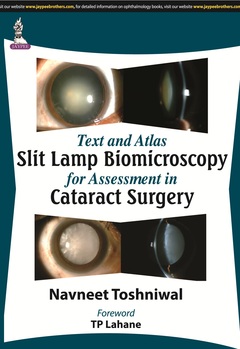Description
Text and Atlas: Slit Lamp Biomicroscopy for Assessment in Cataract Surgery
Author: Toshniwal Navneet
Language: English
Subjects for Text and Atlas: Slit Lamp Biomicroscopy for Assessment...:
Approximative price 45.82 €
In Print (Delivery period: 14 days).
Add to cart220 p. · 15.8x24.1 cm · Paperback
Description
/li>Contents
/li>Biography
/li>
The slit lamp is an instrument consisting of a high-intensity light source that can be focused to shine a thin sheet of light into the eye. It is used in conjunction with a biomicroscope. The lamp facilitates an examination of the anterior segment, or frontal structures and posterior segment of the eye. The binocular slit-lamp examination provides a stereoscopic magnified view of the eye structures enabling anatomical diagnoses to be made for a variety of eye conditions.
This book is a comprehensive guide to the use of slit lamp biomicroscopy for assessment in cataract surgery, with emphasis on preoperative examination. Divided into three sections, it begins with detail on types of cataract related to different anatomical regions of the eye.
The second section discusses cataracts according to aetiology, such as diabetic cataract, traumatic cataract and steroid-induced cataract; whilst the final section examines cataracts with numerous associated conditions.
Each chapter summarises key points for quick revision and nearly 550 images and illustrations enhance learning.
Key points
- Guide to the use of slit lamp biomicroscopy for assessment in cataract surgery
- Covers cataracts related to anatomy, aetiology and associated disorders
- Each chapter includes key learning points
- Highly illustrated with numerous images and diagrams
Section 1: Types of Cataract Related to Anatomy
- Normal Cataract
- Anterior Subcapsular Cataract
- Posterior Subcapsular Cataract
- Posterior Polar Cataract
- Soft Cataract
- Mature Cataract
- Hard Cataract
- Cataract with Small Size Nucleus
- Cataract with Big Size Nucleus
- Cataract with no Nucleus
- Cortical Cataract
- Diffuse Cataract
- Cataract with Weak Zone
Section 2: Types of Cataract According to Etiology
- Developmental Cataract
- Diabetic Cataract
- Steroid-induced Cataract
- Traumatic Cataract
- Cataract with Uveitis
- Subluxated Cataract
Section 3: Cataract with Associated Conditions and Factors
- Cataract with Pseudoexfoliation
- Cataract with Shallow Anterior Chamber
- Cataract with Small Pupil
- Cataract with Suspicious Weak Zonules
- Cataract with Corneal Opacity and Hazy Cornea
- Cataract with Different Shapes of Pupil
- Cataract with Hyperopia
- Cataract with Myopia
- Cataract with Embedded Foreign Body in the Lens
- Cataract with Floppy Iris Syndrome
- Cataract with Glaucoma
- Cataract with Iris Coloboma
- Cataract with Micro-ophthalmos
- Cataract with Vitreous Opacities
- Cataract with Pterygium
- Cataract with Mooren’s Ulcer
- Cataract in Post-radial Keratotomy Case
- Cataract in Post-penetrating Keratoplasty Case
- Cataract in Post-trabeculectomy Cases
- Cataract in Young Age
- Cataract in Old Age
- Cataract with Uneven Anterior Chamber
- Cataract with Wrinkling of Face
Navneet Toshniwal MBBS MS
Ophthalmologist, Consultant and Director, Navneet Hospital, Solapur, Maharashtra, India
These books may interest you

Cataract Surgery in Diseased Eyes 241.25 €



